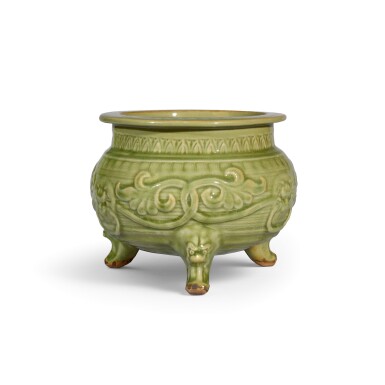Monochrome III
Monochrome III

Property of a Gentleman 士紳珍藏
A large moulded Yaozhou celadon incense burner Jin dynasty | 金 耀州青釉纏枝花三足香爐
Auction Closed
April 22, 03:40 AM GMT
Estimate
2,000,000 - 3,000,000 HKD
Lot Details
Description
Property of a Gentleman
A large moulded Yaozhou celadon incense burner
Jin dynasty
士紳珍藏
金 耀州青釉纏枝花三足香爐
sturdily potted and decorated around the compressed globular body with foliate scrolls alternating with mythical beast masks suspending fixed rings, each of the splayed legs further rendered with a mythical beast mask, all below plantain blades and keyfret borders encircling the constricted neck and shoulder
mouth d. 19.6 cm
Acquired in the 1980s.
1980年代購藏
The present piece is exceptional for its large size, but even more so for its relief designs and the mythical beast masks on its globular body. Yaozhou celadon tripod incense burners are more commonly found carved with bands of flower or leaf scrolls. The pair of mask handles suspending fixed rings is remarkable, demonstrating their inspiration from metal prototypes, which were often adorned with loose rings. Fashioned in resemblance to archaic bronze incense burners both in its form and decoration, this incense burner might have appealed to the aristocratic taste of the time.
Located in the Shaanxi province in Northern China, Yaozhou was a production centre of ceramics for hundreds of years. Since the Tang dynasty (618-907), the kilns had created a wide range of ceramics in varying styles. Perhaps inspired by the success of the Yue celadon kilns of Zhejiang in southern China, by the Five Dynasties period (907-960) Yaozhou produced predominantly green-glazed stoneware for which it is best known today. During the Northern Song dynasty (960-1127) Yaozhou kilns saw their peak production, becoming the foremost manufactories of celadon wares in China. They had developed a style of their own, suitable for production on a large scale, and produced not only for the home market but also for export abroad. While they manufactured bowls and dishes with carved or moulded designs in vast quantities, vessels in other shapes, such as the present incense burner, are rare but were generally given particular attention.
See a Yaozhou tripod incense burner from the collection of the Chang Foundation, Taipei, similarly moulded and applied with foliage between lion-mask and ring motifs, illustrated in James Spencer, Zhongguo lidai taoci xuanji / Selected Chinese Ceramics from Han to Qing Dynasties, Taipei, 1990, pl. 38. Compare also three incense burners with relief decoration of the archaistic kui phoenix from the Jin Dynasty (1115-1234); one in the Museum of Oriental Ceramics, Osaka, and one with upright handles in the Shanxi History Museum, both illustrated in The Masterpieces of Yaozhou Ware, Osaka, 1997, cat. nos 104 and 105; and one in the Shang Shan Tang Collection, illustrated in Marvels of Celadon: The Shang Shan Tang Collection of Yaozhou Wares, Hong Kong, 2019, cat. no. 91.
本品尺寸碩大,爐身浮雕獸面、卷葉紋飾,珍稀罕見。耀州窰三足爐多以刻花技法綴飾花葉紋,反觀本品之獸面銜環浮雕,應源自金屬器常見活環耳。造形、紋飾皆以高古青銅器為本,此爐或迎合當朝仕紳品味。
耀州窰位於中國北方陝西一帶,製陶傳統已有數百年歷史,唐朝以降,可見變化豐富之耀州陶瓷。或得浙江越窰影響,五代之際,耀州窰已以生產青瓷為主,北宋時產量達到顛峰,成為當時中國主要青瓷產地,風格明確,可大量生產,不僅提供境內需求,亦外銷各國。其生產之盌盤器皿,大量製造,多以模印、刻花裝飾,其他器形,如香爐,則相對少見,且製作精緻。
參考鴻禧美術館藏一件耀州窰三足爐,模印卷葉紋飾搭配獸面銜環浮雕,刊載於史彬士,《中國歷代陶瓷選集》,台北,1990年,圖版38。比較三例金代模印仿古夔鳳紋爐,一例藏於大阪市立東洋陶瓷美術館,一存於山西歷史博物館,為沖耳式爐,皆錄於《The Masterpieces of Yaozhou Ware》,大阪,1997年,編號104、105;另一例為上善堂收藏,載於《Marvels of Celadon: The Shang Shan Tang Collection of Yaozhou Wares》,香港,2019年,編號91。
